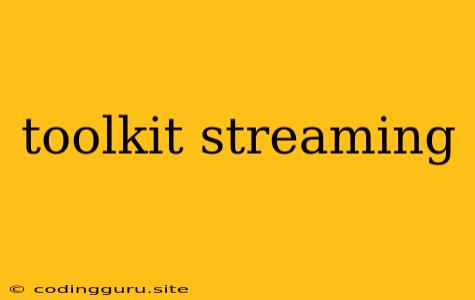What is a Streaming Toolkit?
A streaming toolkit is a collection of software tools and libraries that help you build and manage streaming applications. These applications can be used to process real-time data from various sources, perform operations on that data, and deliver it to different destinations. Streaming toolkits are essential for building modern, data-driven applications that require real-time insights and analysis.
Why Use a Streaming Toolkit?
There are several reasons why using a streaming toolkit is beneficial:
- Real-time Data Processing: Streaming toolkits enable you to process data as it arrives, allowing you to react to events and trends in real-time. This is crucial for applications like fraud detection, anomaly detection, and real-time analytics.
- Scalability and Performance: These toolkits are designed to handle high volumes of data and perform complex calculations at scale. They offer distributed architectures and parallel processing capabilities for optimal performance.
- Flexibility and Extensibility: Streaming toolkits provide a wide range of features and modules, allowing you to customize your streaming pipeline based on your specific needs. You can easily integrate with different data sources and destinations.
- Ease of Development and Management: The toolkits often include libraries and frameworks that simplify the development and management of streaming applications. This helps reduce the time and effort required to build and deploy your solutions.
Types of Streaming Toolkits
There are various types of streaming toolkits available, each with its strengths and weaknesses. Some popular choices include:
- Apache Kafka: A distributed streaming platform known for its high throughput, durability, and scalability. It's widely used for building real-time data pipelines.
- Apache Flink: A powerful streaming engine with support for state management, windowing, and complex event processing. It's suitable for applications requiring advanced analytics and low latency.
- Apache Spark Streaming: A micro-batch processing framework that provides an efficient way to handle large datasets in near real-time. It's well-suited for batch-oriented data processing tasks.
- Amazon Kinesis: A fully managed streaming service offered by AWS. It provides a scalable and reliable platform for capturing, processing, and analyzing real-time data streams.
- Google Cloud Pub/Sub: A fully managed message queueing service from Google Cloud. It enables you to build scalable and reliable message-driven applications with real-time messaging capabilities.
Choosing the Right Streaming Toolkit
The choice of streaming toolkit depends on your specific needs and requirements. Consider the following factors:
- Data volume and velocity: Choose a toolkit capable of handling the expected volume and speed of your data streams.
- Latency requirements: If your application requires low latency processing, consider using a toolkit with strong real-time capabilities.
- Data processing needs: Select a toolkit that provides the necessary features for your data processing tasks, such as windowing, aggregation, and joins.
- Integration with existing infrastructure: Ensure the toolkit integrates well with your existing data sources, databases, and applications.
- Skillset and expertise: Choose a toolkit that aligns with your team's skills and experience.
Getting Started with Streaming Tooling
Once you've chosen a streaming toolkit, you need to get started with its development and deployment. Follow these general steps:
- Set up your environment: Install the necessary software and configure your development environment.
- Define your data sources and destinations: Identify where your data originates from and where you want it to be sent.
- Design your streaming pipeline: Plan the data flow, processing steps, and any transformations required.
- Develop your streaming application: Use the toolkit's libraries and APIs to build your application code.
- Test and debug your application: Thoroughly test your application with realistic data to ensure it functions as expected.
- Deploy your application: Choose a deployment strategy that suits your needs, such as running on your own infrastructure or using a cloud service.
Conclusion
Streaming toolkits are essential components for building modern data-driven applications that require real-time insights and analysis. By leveraging the features and capabilities of these toolkits, developers can build scalable, performant, and flexible streaming applications that meet the demands of today's data-intensive world.
